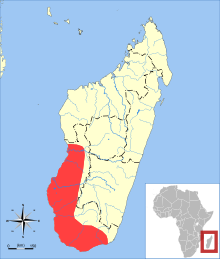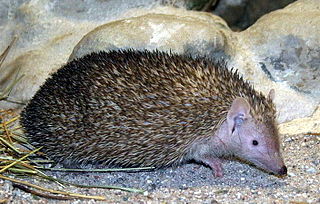
The clade Afrosoricida contains the golden moles of Southern Africa, the otter shrews of equatorial Africa and the tenrecs of Madagascar. These three groups of small mammals were for most of the 19th and 20th centuries regarded as a part of the Insectivora or Lipotyphla, but both of those groups, as traditionally used, are polyphyletic.

A tenrec is any species of mammal within the afrotherian family Tenrecidae, which is endemic to Madagascar. Tenrecs are a very diverse group; as a result of convergent evolution some resemble hedgehogs, shrews, opossums, rats, and mice. They occupy aquatic, arboreal, terrestrial, and fossorial environments. Some of these species, including the greater hedgehog tenrec, can be found in the Madagascar dry deciduous forests. However, the speciation rate in this group has been higher in humid forests.
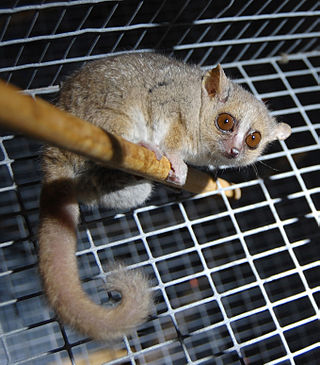
The gray mouse lemur, grey mouse lemur or lesser mouse lemur, is a small lemur, a type of strepsirrhine primate, found only on the island of Madagascar. Weighing 58 to 67 grams, it is the largest of the mouse lemurs, a group that includes the smallest primates in the world. The species is named for its mouse-like size and coloration and is known locally as tsidy, koitsiky, titilivaha, pondiky, and vakiandry. The gray mouse lemur and all other mouse lemurs are considered cryptic species, as they are nearly indistinguishable from each other by appearance. For this reason, the gray mouse lemur was considered the only mouse lemur species for decades until more recent studies began to distinguish between the species.
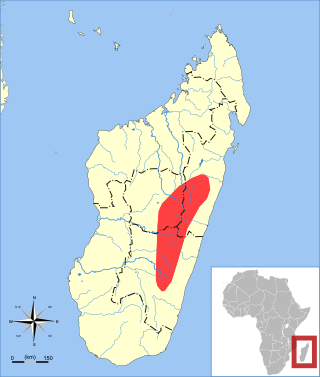
The web-footed tenrec, Malagasy otter shrew, or aquatic tenrec is the only known semiaquatic tenrec, and is found in eastern Madagascar, especially in and around Ranomafana National Park. It grows to between 25 and 39 cm, and was once thought to be extinct. It feeds on crabs, aquatic insects, and crayfish. The population is considered vulnerable. It was formerly placed in the monotypic genus Limnogale, but has been moved to Microgale based on molecular data showing it to be deeply nested within the latter.
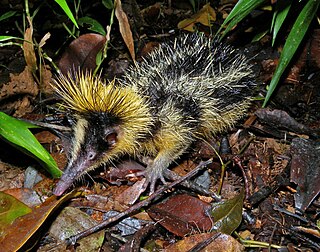
The lowland streaked tenrec is a small tenrec found in Madagascar. It belongs to the family Tenrecidae in the order Afrosoricida, and more specifically to the subfamily of the spiny tenrecs Tenrecinae. Its natural habitats are in tropical lowland rain forests in northern and eastern parts of Madagascar.
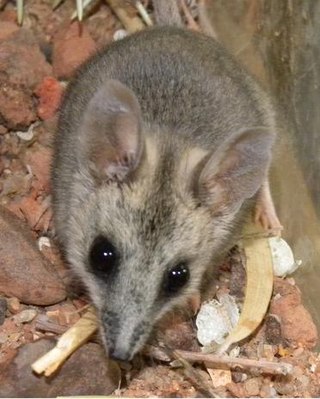
The striped-faced dunnart is a small, Australian, nocturnal, "marsupial mouse," part of the family Dasyuridae. The species' distribution occurs throughout much of inland central and northern Australia, occupying a range of arid and semi-arid habitats.

The tailless tenrec, also known as the common tenrec, is a species of mammal in the family Tenrecidae. It is the only member of the genus Tenrec. Native to Madagascar, it is also found on the Comoros, Mauritius, Réunion, and Seychelles island groups, where it has been purposely introduced. Its natural habitat is the understory of subtropical-tropical forest, open forest, arid shrub-land, savanna, arable land, pastures, crop plantations, private gardens, and some landscaped, urban areas.
Amblysomus is a genus of the golden mole family, Chrysochloridae, comprising five species of the small, insect-eating, burrowing mammals endemic to Southern Africa. All five species can be found in South Africa and some are also found in Eswatini and Lesotho.

The large-eared tenrec is a species of mammal in the family Tenrecidae. It is the only species in the monotypic genus Geogale, and the only member of the subfamily Geogalinae. It is endemic to Madagascar where its natural habitats are subtropical or tropical dry forests and shrubland. It is threatened by habitat loss, but to a lesser extent than was previously thought and is listed by the IUCN as being of "Least Concern".

Jenkins's shrew tenrec is a species of mammal in the family Tenrecidae. It is endemic to Madagascar. Its natural habitats are subtropical or tropical dry forests and shrubland. It is threatened by habitat loss.

The lesser long-tailed shrew tenrec is a species of mammal in the family Tenrecidae. It is active at all hours of the day and night, but each individual maintains its own pattern of rest and activity.

The greater hedgehog tenrec, also known as the large Madagascar hedgehog or sokina, is a species of mammal in the family Tenrecidae. It is endemic to Madagascar. Its natural habitats are subtropical or tropical forests, shrubland and grassland, savanna, rural gardens, and urban areas.

The Asian garden dormouse or large-eared garden dormouse, is a species of rodent in the family Gliridae. It is found in Egypt, Iraq, Israel, Jordan, Lebanon, Libya, Saudi Arabia, Syria and Turkey. Its natural habitats are temperate forests, subtropical or tropical dry shrubland, Mediterranean-type shrubby vegetation, rocky areas and gardens.

Moniliformidae is a family of parasitic spiny-headed worms. It is the only family in the Moniliformida order and contains three genera: Australiformis containing a single species, Moniliformis containing eighteen species and Promoniliformis containing a single species. Genetic analysis have determined that the clade is monophyletic despite being distributed globally. These worms primarily parasitize mammals, including humans in the case of Moniliformis moniliformis, and occasionally birds by attaching themselves into the intestinal wall using their hook-covered proboscis. The intermediate hosts are mostly cockroaches. The distinguishing features of this order among archiacanthocephalans is the presence of a cylindrical proboscis with long rows of hooks with posteriorly directed roots and proboscis retractor muscles that pierce both the posterior and ventral end or just posterior end of the receptacle. Infestation with Monoliformida species can cause moniliformiasis, an intestinal condition characterized as causing lesions, intestinal distension, perforated ulcers, enteritis, gastritis, crypt hypertrophy, goblet cell hyperplasia, and blockages.

Tenrecinae is a tenrec subfamily endemic to the island of Madagascar. It contains the largest species in the family, Tenrec ecaudatus. All members of the genus possess spines, analogous to those of hedgehogs, for defense against predators.

The Madagascar succulent woodlands are a xeric shrublands ecoregion in southwestern and central western Madagascar. Native plants survive in the arid climate and long dry season with adaptations like succulent leaves, water storing trunks, photosynthetic stems, and dropping leaves during the dry season. The ecoregion is threatened by various human activities.

Volvation, is a defensive behavior in certain animals, in which the animal rolls its own body into a ball, presenting only the hardest parts of its integument, or its spines to predators.

